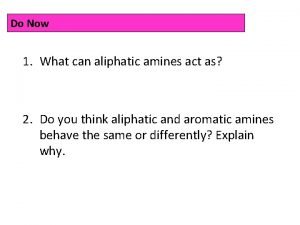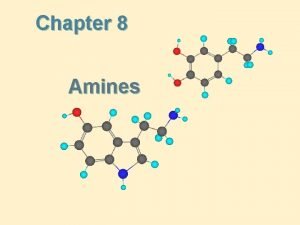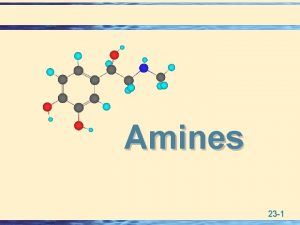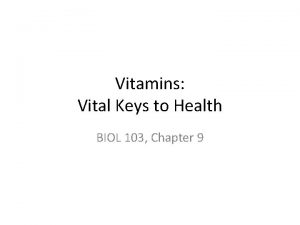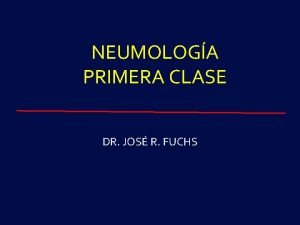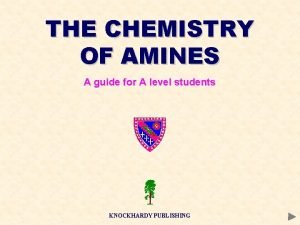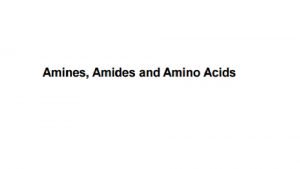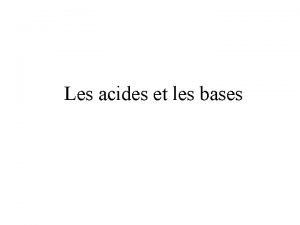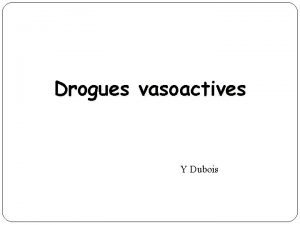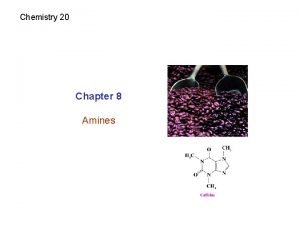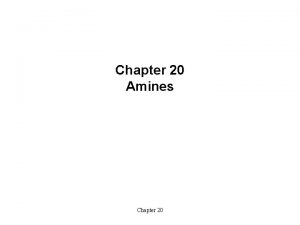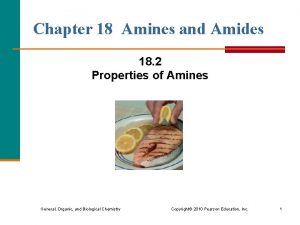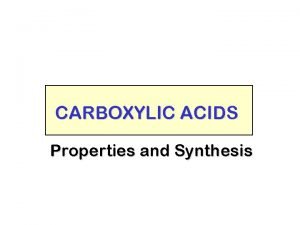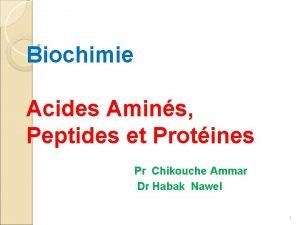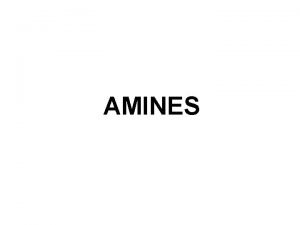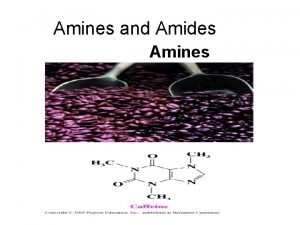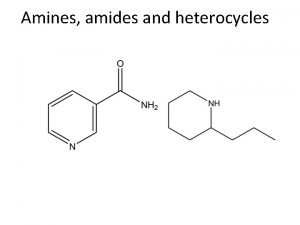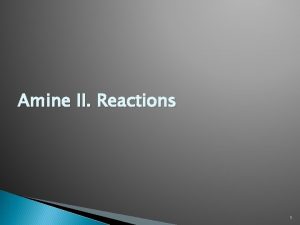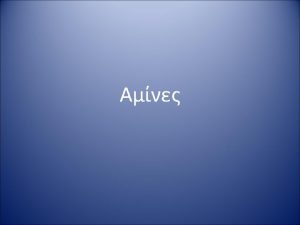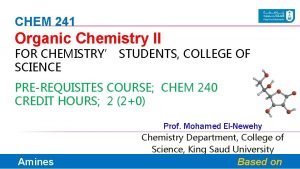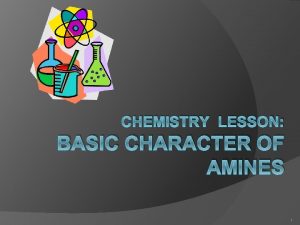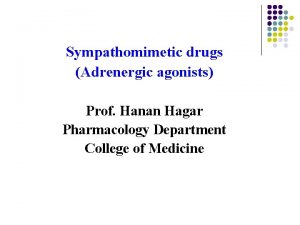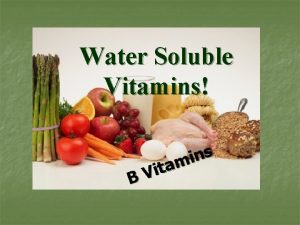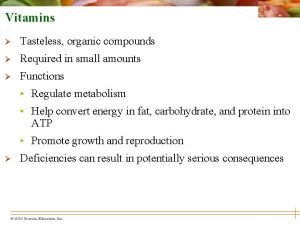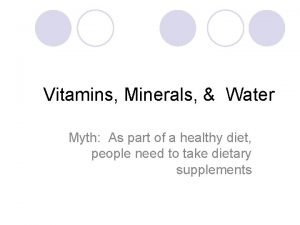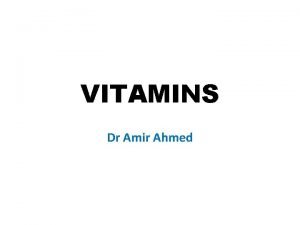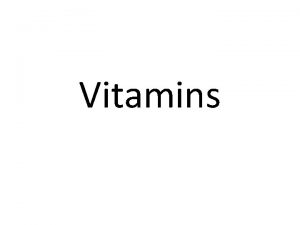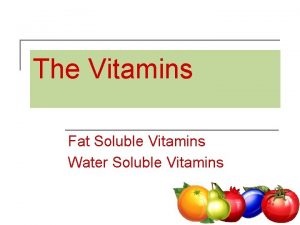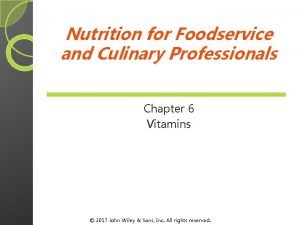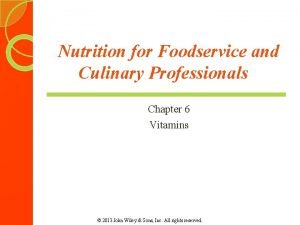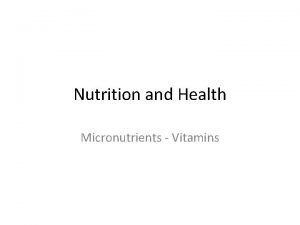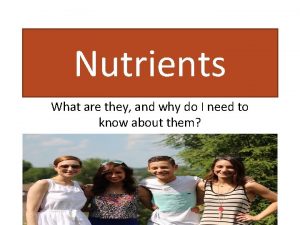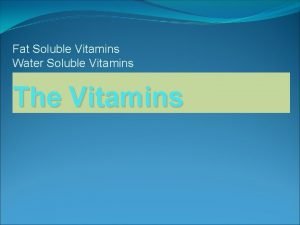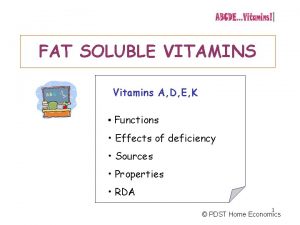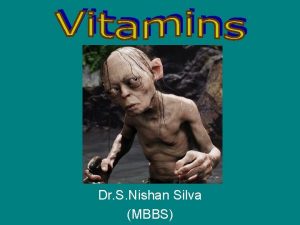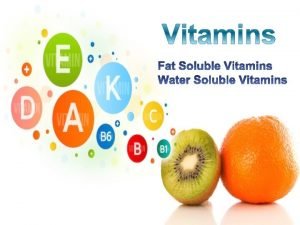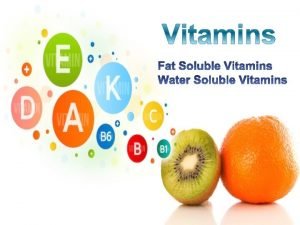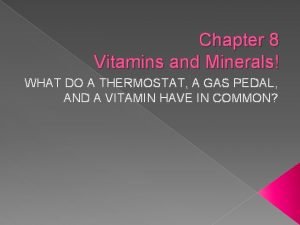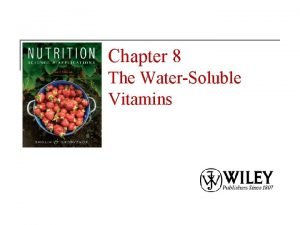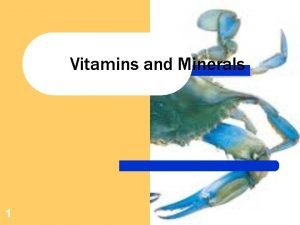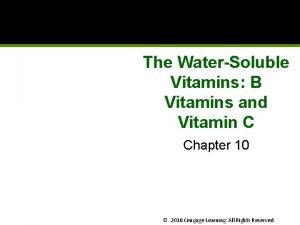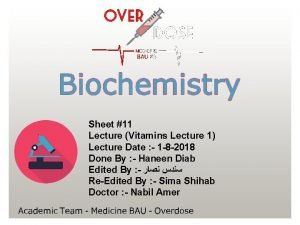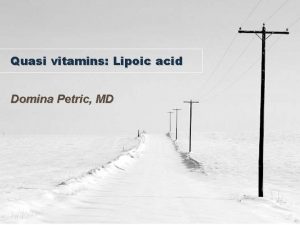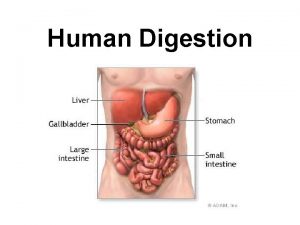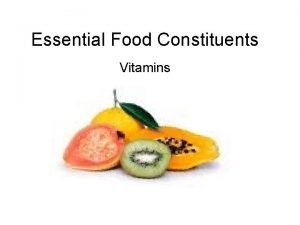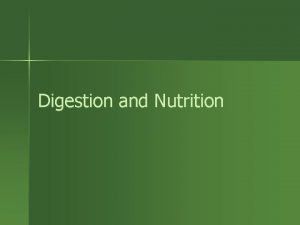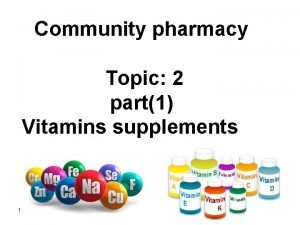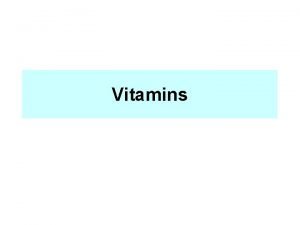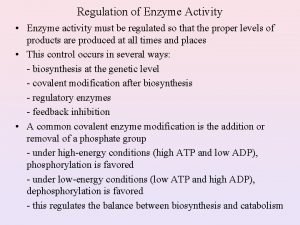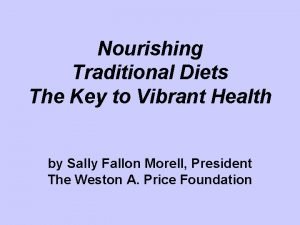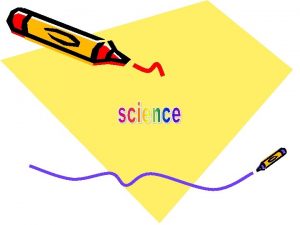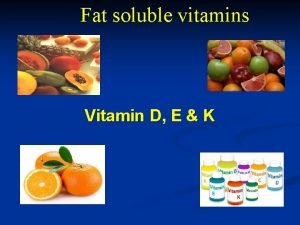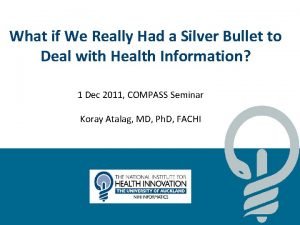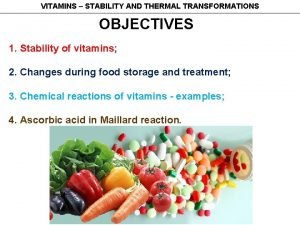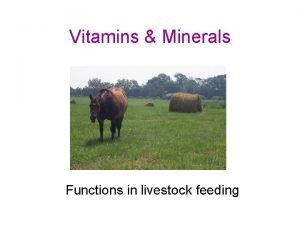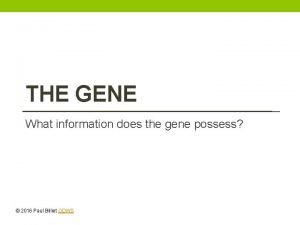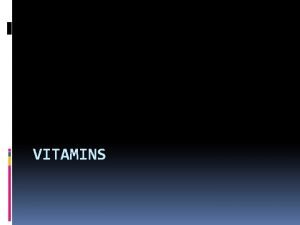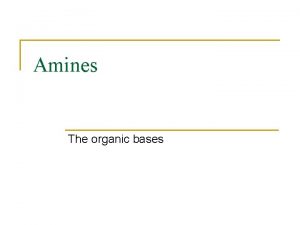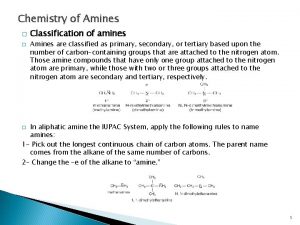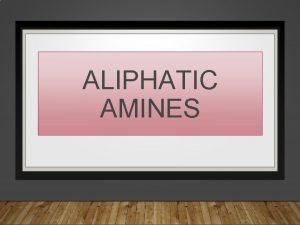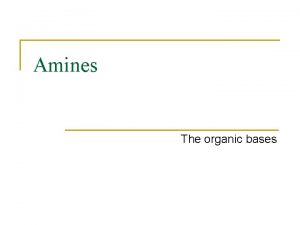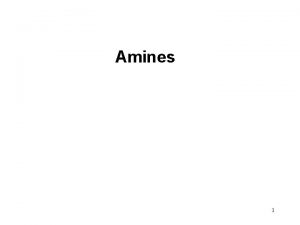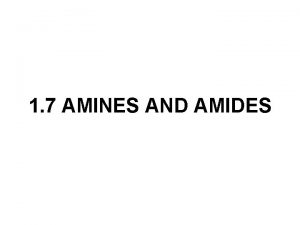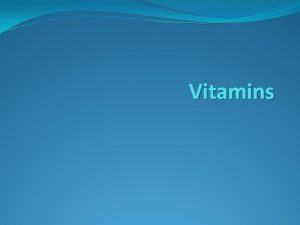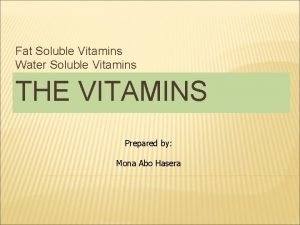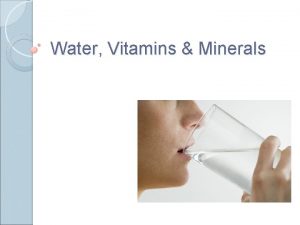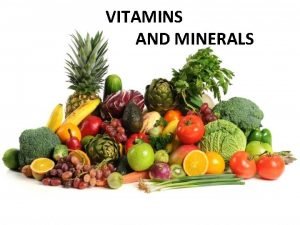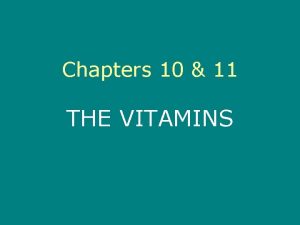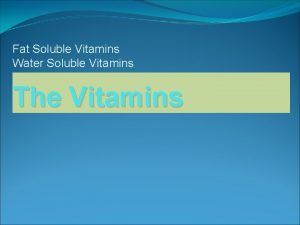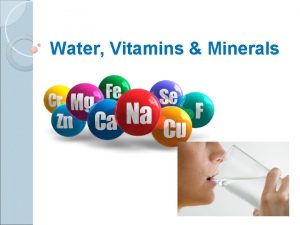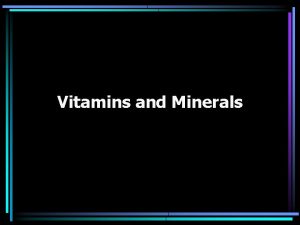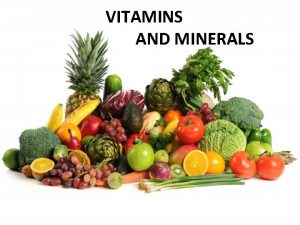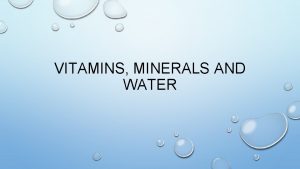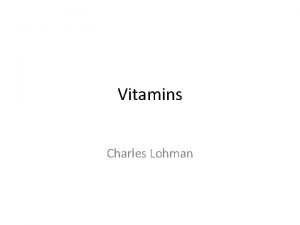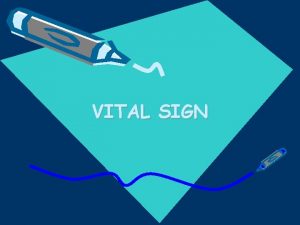vitamins Vital amines VITAMINS vita life amines 1
![vitamins Vital amines VITAMINS = vita [life] +[amines] vitamins Vital amines VITAMINS = vita [life] +[amines]](https://slidetodoc.com/presentation_image_h2/dc64cff5b192e708e8e189a7ba7a1acf/image-1.jpg)


![II –Hvpovitaminosis [vitamins deficiencv] -Avitaminosis Lack of one or more vitamins produces characteristic syndromes II –Hvpovitaminosis [vitamins deficiencv] -Avitaminosis Lack of one or more vitamins produces characteristic syndromes](https://slidetodoc.com/presentation_image_h2/dc64cff5b192e708e8e189a7ba7a1acf/image-4.jpg)
![1. 2. 3. 4. 5. Decreased [inadequate] intake : such as those occur in 1. 2. 3. 4. 5. Decreased [inadequate] intake : such as those occur in](https://slidetodoc.com/presentation_image_h2/dc64cff5b192e708e8e189a7ba7a1acf/image-5.jpg)

![11 - therapeutic diet [total parenteral nutrition ] : when therapeutic diet is used 11 - therapeutic diet [total parenteral nutrition ] : when therapeutic diet is used](https://slidetodoc.com/presentation_image_h2/dc64cff5b192e708e8e189a7ba7a1acf/image-7.jpg)












![9 -Recommended Dietary Allowance [RDA] : It varies according to age, individual condition, sex 9 -Recommended Dietary Allowance [RDA] : It varies according to age, individual condition, sex](https://slidetodoc.com/presentation_image_h2/dc64cff5b192e708e8e189a7ba7a1acf/image-20.jpg)
![Vitamin D =Steroid pre[o]-hormone = Anti-rachitic vitamin =Calciol= Calcitriol = sun shine Vitamin. 1 Vitamin D =Steroid pre[o]-hormone = Anti-rachitic vitamin =Calciol= Calcitriol = sun shine Vitamin. 1](https://slidetodoc.com/presentation_image_h2/dc64cff5b192e708e8e189a7ba7a1acf/image-21.jpg)




























![5 -Hypovitaminosis : there are no evidences[facts] for its deficiency in man , however 5 -Hypovitaminosis : there are no evidences[facts] for its deficiency in man , however](https://slidetodoc.com/presentation_image_h2/dc64cff5b192e708e8e189a7ba7a1acf/image-50.jpg)












![VIII- Vitamin antagonists [Antivitamins] Certain substances have antivitamin [s] properties and enter with the VIII- Vitamin antagonists [Antivitamins] Certain substances have antivitamin [s] properties and enter with the](https://slidetodoc.com/presentation_image_h2/dc64cff5b192e708e8e189a7ba7a1acf/image-63.jpg)


- Slides: 65
![vitamins Vital amines VITAMINS vita life amines vitamins Vital amines VITAMINS = vita [life] +[amines]](https://slidetodoc.com/presentation_image_h2/dc64cff5b192e708e8e189a7ba7a1acf/image-1.jpg)
vitamins Vital amines VITAMINS = vita [life] +[amines]

1 – Introduction Diet contains only purified carbohydrates, proteins, lipids , minerals and water, can not sustain life. Additional factors , present in natural foods are also required. These accessory food factors are called vitamins. The term vitamin was introduced in 1911 , and the first vitamin discovered and isolated in a pure crystalline form was effective in preventing and curing a dietary deficiency disease called [polyneuritis]. The name vitamin was proposed for this compound because of its vital need in the preventing and curing of the above pathological condition and because chemically it was found to be an amine. Latter on , when other vitamins were discovered and found that they were not amines, the final [e] was dropped. Now a days , the term vitamin is used to a group of biologically essential organic chemical compounds have no chemical resemblance to each other , but because of a similar general function in metabolism.

Generally , the vitamins can not be synthesized by man and most other animals and they must be supplied in the diet , however , no single food is a rich source of all vitamins. Before the chemical structures of the vitamins were known , they were identified by letters of alphabete. This system is gradually being replaced by a nomenclature based on the chemical nature of the compound or a description of its source or function. normal growth , development and maintenance of health. Inside the human body , vitamins undergo biotransformation and converted to more complex compounds [co-enzymes] that playa key role in many cellular reactions. The average daily requirement for vitamins differs from one vitamin to another and its influenced by age , sex[gender], pregnancy, lactation, physical stress and nutritional state.
![II Hvpovitaminosis vitamins deficiencv Avitaminosis Lack of one or more vitamins produces characteristic syndromes II –Hvpovitaminosis [vitamins deficiencv] -Avitaminosis Lack of one or more vitamins produces characteristic syndromes](https://slidetodoc.com/presentation_image_h2/dc64cff5b192e708e8e189a7ba7a1acf/image-4.jpg)
II –Hvpovitaminosis [vitamins deficiencv] -Avitaminosis Lack of one or more vitamins produces characteristic syndromes and generally. hypovitaminosis is divided into two principal types : I - Primary hvpovitaminosis This results from deficient intake or deficiency of the vitamin[s] in the diet. 2 - Secondary [conditioned] hypovitaminosis This arises not because of a lack of vitamin[s] in the diet , but because of:
![1 2 3 4 5 Decreased inadequate intake such as those occur in 1. 2. 3. 4. 5. Decreased [inadequate] intake : such as those occur in](https://slidetodoc.com/presentation_image_h2/dc64cff5b192e708e8e189a7ba7a1acf/image-5.jpg)
1. 2. 3. 4. 5. Decreased [inadequate] intake : such as those occur in cases of: prolonged vomiting, loss of teeth , long standing organic diseases-------etc. Decreased[inadequate] absorption : such as those occur in cases of malabsorption [diarrhea , biliary obstruction and intestinal diseases]. Impaired [inadequate]utilization when the vitamin[s] are not used properly. Increased elimination : such as those occur in cases of diarrhea. diuresis , lactation and blood loss. Increased requirement : certain vitamins are needed in excess in cases of growth , pregnancy , lactation , wound healing , excess alcohol consumption and diet rich in carbohydrates.

6 - Faulty bacterial synthesis: The biosynthesis of certain vitamins which are made up by certain intestinal bacteria is inhibited , when antibiotics are used. . 7 - Bacterial destruction : such as decomposition of vitamin c by intestinal bacteria. 8 - Inadequate conversion of the pro vitamin into active vitamin. 9 - Vitamin inhibitors[antagonists] : such as PABA and Sulphonamides , Thiaminase present in raw fishes that hydrolyzes vitamin B 1. 10 - Imbalance : its known that is necessary to make a balnce between water and fat soluble vitamins.
![11 therapeutic diet total parenteral nutrition when therapeutic diet is used 11 - therapeutic diet [total parenteral nutrition ] : when therapeutic diet is used](https://slidetodoc.com/presentation_image_h2/dc64cff5b192e708e8e189a7ba7a1acf/image-7.jpg)
11 - therapeutic diet [total parenteral nutrition ] : when therapeutic diet is used for long periods , there will he vitamin deficiency such as glucose saline. 12. Chronic alcoholism for example alcohol inhibits intestinal absorption. of Vit. B 1 causing it's deficiency.

Hypovitaminosis of any type if prolonged, leads to avitaminosis , which is characterized by : 1. 2. 3. 4. 5. A gradual decrease in tissue level of vitamins. Biochemical lesions. Anatomic lesions. Cellular pathology [diseases]. Death

III –Hyper vitaminosis Generally , fat soluble vitamins are more storable in human body , so excessive intake can result in toxic conditions. However , with the exception of vitamins A, D and E , there is little danger of toxic manifestations from the usual amount of vitamins , present , either in the diet or in the ordinary vitamin supplements , for example : The minimum lethal dose for Niacin is 6 G. /Kg. body wt. /day, so for a person of 60 Kg body wt. this is equal to 6*60=360 G/day , no one takes this quantity.

IV-Biosyntliesis of vitamins Generally , the vitamins can not be synthesized by man and most other animals and they must be supplied in the diet , however, certain vitamins are synthesized to greater or less extent in the human body : 1 - This may occurs as a result of bacterial growth in the intestinal tract. for example bacteria produce considerable amounts of vitamins K 2, B 5, B 7 and B 12. 2 - Metabolic biotransformation of the essential amino acid [tryptophan] to niacin. 3 - Vitamin D 3 may be synthesized from cholesterol by the skin , if its properly exposed to adequate sun shine

VII-Classification of vitamins: Vitamins solubility in water or fat is used for their classification : 1 - Fat soluble vitamins : this group includes : vitamins A, D, E and k , they are usually associated with the lipids of natural foods. Chemically they belong to isoprenoids. 2 - Water soluble vitamins : this group includes : vitamin C and B complex vitamins.

1 - Fat soluble vitamins 1 - Vitamin A 1 - Properties : soluble in fat and fat solvents discovered in 1913 , stable at high temperature , destroyed by U. V. light, found either as vitamin A or as its precursor which is called pro vitamin A or Beta-carotene , which is converted after its absorption to vit. A in the intestinal wall and liver. 2 - Chemistry : vit. A is a complex primary alcohol, the terminal [OH] group is esterified mostly with palmitic acid [C 16 : 0] , its structural formula is characterized by the presence of beta ionone ring.

There are two principal types of vit. A : 1 -Vit. Al or Retinol = Retinal 2 -Vit. A 2 or 3 -dehydroretinol , which has a potency of 40% of that of vit. Al and its structural formula differs from that of vit. A 1 , only in the presence of an additional double bond between C 3 and C 4 in the beta ionone ring. Vit. Al may be derived from beta-carotene by cleavage of the chain in a dioxygenase reaction in the presence of oxygen yielding two molecules of vit. Al.

3 -Occurrence : Vit. A is found mainly in the following sources either as vit. A or provit. A : cod liver oi 1, fish oils , liver , butter , eggs , cheese , carrot , squash , sweet potatoes , spinach, beet green , tomatoes , peaches , apricot and corn.

5 - Physiologic roles : Includes : I -Vit. A has antioxidant property, so it has an important role in preventing certain. types of cancer , mainly lung cancer. 2 -maintenance of epithelial tissues. 3 -Promotes the formation of skeleton, so its important for growth 4 -Vit. A is necessary for reproduction and lactation. 5 -Certain derivatives of vit. A are used for the treatment of acne and psoriasis. 6 -It has a specific role in the physiologic mechanism of vision [its involved in optic nerve transmission]. Rhodopsin + Retinal protein part non protein part visual purple, retinal pigment, photoreceptor molecule, conjugated protein found in rode and cone cells of the retina of the eyes

When light stricks on the rode and cone cells of the retina of the eyes which contains Rhodopsin , the latter is coverted to opsin and retinol. Normally , equilibrium is maintained in the retina of the eyes such that the rate of breakdown of rhodopsin is equaled by the rate of regeneration. When there is deficiency of vit. A, the rate of rhodopsin regeneration is retarded , and this affects the process of vision and the patient may be a night blind [Nyctalopia].

7 -Hypovitaminosis A : this may be either primary or secondary and characterized by : 1 -Slowing or stopping of growth in young animals. 2 -Avoidance of light[photophobia], and [xerophthalmia] which is characterized by drying of the eyes , the cells of the lacrimal glands become keratinized and stop secreting tears, this may cause blidness if its not treated. 3 -Vit. A deficiency has similar effects on the other epithelial tissues, mainly those of the respiratory and alimentary tracts. 4 -Vit. A deficiency lowers body resistance against bacterial infections. 5 -It causes nyctalopia. 6 -There will be deposition of carotene in the skin.

7 -There also dryness and scaliness of the skin. 8 -Vit. A deficiency leads to the formation of urinary caculi. 9 -There is a defective in the formation of the enamel of the teeth. 10 -Vit. A deficiency causes paralysis and nerve degeneration. 11 -There will be atrophy of the testis. 12 -Vit. A deficiency causes also a delay of wound healing. 13 -The risk of cancer is increased

8 -Hypervitaminosis : ingestion of an excess of vit. A causes : 1 -Anorexia[loss of appetite]. 2 -Irritability[bone pain]. 3 -Fissuring at the corner of the mouth. 4 -Cracking and bleeding of the lips. 5 -Loss of hair. 6 -Hepatosplenomagaly and liver damage. 7 -Headache and muscle stiffness. 8 -Abortion. 9 -Menstrual irregularities
![9 Recommended Dietary Allowance RDA It varies according to age individual condition sex 9 -Recommended Dietary Allowance [RDA] : It varies according to age, individual condition, sex](https://slidetodoc.com/presentation_image_h2/dc64cff5b192e708e8e189a7ba7a1acf/image-20.jpg)
9 -Recommended Dietary Allowance [RDA] : It varies according to age, individual condition, sex and normally its : 4000 I. U. for women. 5000 I. U. for men. This quantity must be increased to 6000 I. U. /day in cases of lactation and pregnancy. l. Ug. = 3 I. U.
![Vitamin D Steroid preohormone Antirachitic vitamin Calciol Calcitriol sun shine Vitamin 1 Vitamin D =Steroid pre[o]-hormone = Anti-rachitic vitamin =Calciol= Calcitriol = sun shine Vitamin. 1](https://slidetodoc.com/presentation_image_h2/dc64cff5b192e708e8e189a7ba7a1acf/image-21.jpg)
Vitamin D =Steroid pre[o]-hormone = Anti-rachitic vitamin =Calciol= Calcitriol = sun shine Vitamin. 1 - Properties : Vit. D is a white crystalline compound , soluble in fat and fat – solvents , discovered in 1933. Vitamins D are a group of compounds that are sterols occurring in nature, principally in animal organisms. Certain of these sterols are pro-vitamin D , and when subjected to long wave U. V. light acquire the physiologic properties of preventing and curing [Rickets] a disease Characterized by skeletal abnormalities including failure of calcification

2 - Chemistry : For nutritional purposes the two principal D vitamins are : - • Vit. D 2 [activated Ergosterol] or Ergocalciferol or Viosterol , which is of vegetable origin. • Vit. D 3 [activated 7 -dehydrocholesterol] or cholecalciferol , which is of animal origin. . Man and other mammals can synthesize pro-vit. D 3 in their bodies. Both vitamins D 2 and D 3 have equal potencies. 3 - Occurrence : Vitamins D are found mainly in : cod liver oi 1, other fish oils. eggs , liver , milk , mush rooms and cereals

5 -Physiologic roles : includes : 1 -Vit. D increases the intestinal absorption of Ca and P. 2 -It has a direct effect on calcification process. 3 -It affects the clearance and excretion of P by the kidneys. 4 -Its also essential for normal Insulin secretion , cell differentiation and immunity. 6 -Hypovitaminosis : its characterized by : 1 -Rickets in children and Osteomalacia in adult. 2 -An increase in the level of serum alkaline phosphatase. 3 -A delay in dentition in children. 4 -Hypoplasia [poor structural development].

7 -Hypervitaminosis : ingestion of an excess of vit. D causes : 1 -Anorexia and weakness. 2 -Nausea and headache. 3 -Digestive disturbances[constipation] and polyuria. 4 -Irreversible damage of kidneys. 5 -Calcification of soft tissues. 6 -Hypercalcuria , resulting in kidney stones. 8 -RDA : varies according to age, sex and individual conditions and normally its about : 2. 5 Mg. in adult and 10 Mg. in infant , children , pregnant and nursing women. l. Ug. = 10 I. U.

Vitamin E = Alpha tocopherol 1 -Properties : fat soluble vit. , soluble in fat and fat solvents , known also as anti-sterility vit Or fertility factor , discovered in 1922. The name tocopherol is a Greek word -means Child-bearing plus an o. L for an alcohol. 2 -Chemistry : There are several tocopherol isomers , like alpha , beta , gamma , delta----etc. , of which the alpha isomer is the most potent and it has the following structural formula :

3 - Occurrence: good sources of vit E are eggs , muscle , liver, fish. chicken , oat meal , corm oil , Soya , cotton seeds and wheat germ oils 4 -physiological roles : 1. 2. 3. 4. Vit. E prevents auto-oxidation[ peroxidation] of polyunsaturated fatty acids, so it can be used as an anti oxidant. It prevents damage of lung tissues caused by various oxidants found in the air Vit. E serves as a co-factor in electron transfer system. Its essential for normal immune system.

5 -Hypovitaminosis : its characterized by: 1 - Resorption of the foetus in females. 2 – Atrophy of the spematogenic tissues and permanent sterility in males , 3 -RBC haemolysis and anemia. 4 -Abnormal metabolism of nucleic acids. 5 -An increase in urinary excretion of creatine. 6 -Steatorrhea , cystic fibrosis and pancreatitis. 6 -Hpervitaminosis : its characterized by : malaise and fatigability.

RDA : It varies according to age, sex, individual conditions and the amount of P. U. S. F. A in the diet. [vit. E/P. U. S. F. A. ]= 0. 6. Normally its about 10 Mg. /day. 1 I. U. =0. 67 Mg. Tocopherol.

Vitamins K: 1 - Properties : fat soluble vitamin , soluble in fat and fat solvents , known also as koagulating [Denmark] vit. , so the name vit. K, discovered in 1920 2 -Chemistrv : a large number of chemical compounds which are related to 2 -methyl-1, 4 naphthoquinone posses some degree of vit. K activity. The principal types of vit. K are : 1 - Vit. K 1= Mephyton = Phytonadione =Phylloquinone = 2 methyl-3 -phytyl 1, 4 - naphthoquinone, this type of vit. K is of plant origin.

2 - Vit. K 2 =Menaquinone =Farnoquinone =2 -methyl-3 difamesyl 1, 4 naphthoquinone, it occurs as a metabolic product of intestinal bacteria as well as in animal tissues

3 - Vit. K 3 -Menadione = 2 -methyl-1, 4 –naphthoquinone , is a synthetic compound. This suggested that this portion[2 methyl 1, 4 -naphthoquinone] of the molecule is essential for biologic effects.

4 - Occurrence : vit. K is found mainly In : liver, G. I. T. , skeletal muscles , cows milk, cheese , kale, cabbage , cauliflower , alfalfa, peas, and cereals. 5 -Phvsiologic roles : include : 1 -Vit. K catalyzes the biosynthesis of several plasma clotting factors such as factors : 11 [prothrombin]. V 11, 1 X and X. 2 -It catalyzes the oxidative phosphorylation. 3 -It induces RNA formation. 4 -Vit. K has an important role in Ca metabolism. 5 -It may be used as anti-dote for anti-coagulant drugs such as coumarine derivatives. 6 -It has also an important role in mineralization process.

6 -Hypovitaminosis : its characterized by : 1 -Episiaxis and excessive menstrual loss. 2 -Haematuria. 3 - G. I. T. harmorrhage. 4 -Hypoprpothrombinemia. 7 -Hypervitaminosis : its characterized by : 1 -Hyperbilirubinemia and haemolytic anemia. 2 -Liver damage. 3 -Reduced effectiveness of anti-coagulants

RDA: varies from 60 -80 Ug. /day Note : 1 - Warfarin prevents the conversion of pro-vit. K to functional hydroquinone. 2 - Synkavite[sod. menadiol di-phosphate] and Hykinone [menadione sod-bis-sulfite] are water soluble compounds with vit. K activity .

II-Water soluble vitamins 1 - Vitamin C =Ascorbic acid 1 - Properties : ascorbic acid is a simple sugar , the most reduced agent found in living tissues , easily and reversibly oxidized to dehydroascorbic acid. Its highest concentration is in the adrenal cortex and eyes , its easily destroyed by heat and alkalies , discovered in 1928. 2 -Chemistry : the chemical structure of ascorbic acid resembles that of monosaccharides and it has the following structural formula :

3 -Occurrence : vit. C is best obtained from : citrus fruits , tomatoes , peppers, parsely, spinach, cabbage, liver, fish, and milk. 4 -Physiologic roles : include : 1 - Vit. C has an important role in metabolism mainly oxidoreduction reactions. 2 - The major function of vit. C is the formation of tissue Collagen [intra-cellular cement substance]. 3 - It has also an important role in : metabolism of proline , lysine and tyrosine, conversion of folic acid to FH 4, hydroxylation of cholesterol to bile acids [cholic acid] and absorption and utilization of Fe and Cu. 4 -Vit. c protects cells against free radical damage. 5 -Vit. C acts as a general water soluble anti-oxidant and inhibits the formation of Nitrosamines [carcinogenic] formed from nitrites

5 -Hypovitaminosis : characterized by : 1 - Stopping of growth in young animals. 2 - Scurvy which is characterized by : lassitude , anemia , painful limbs , bleeding and slow healing of wounds. 3 -A decrease of body resistance to infections. 4 -A decrease of aminoacid metabolism.

6 -RDA : varies according to age, sex and individual conditions and normally its about 35 Mg. /day in infants , 45 Mg. /day in adults. This quantity must be increased into 6 OMg. /day for pregnant and nursing women. Notes 1 The need for vit. C is increased in : thyrotoxicosis, achlorhydria, diarrhea , rheumatic fever , surgery and common cold. 2 - We must be a ware that large doses[mega doses] for example [4 gm/ day] of vit. C may be dangerous , since its metabolism involves the formation of oxalate , that can combine with Ca forming Ca-oxalate which is one the important urinary stones.

2 -B-complex vitamins The members of vit. B- complex are : I - Vit. B 1 =thiamin[e] =anti-beri factor=anti - neuritic factor= aneurine. 2 - Vit. B 2=riboflavin=lactoflavin. 3 - Vit. B 3= niacin[nicotinic acid +nicotinamide or niacinamide] =P-P factor of gold berg. 4 - Vit. B 5 =pantothenic acid =filterate factor =chick antidermatite factor. 5 - Vit. B 6 -pyridoxine =rat anti-dermatitis factor. 6 - Vit. B 7 =biotin=vit. F-anti-egg white injury factor. 7 - Vit. B 9 =folic acid =pteroglutamic acid =Vit. M. 8 - Lipoic acid =thioctic acid. 9 - Vit. B 12 = cobalamin = cyanocobalamin. 10 - Inositol. 11 - PABA.

1 - Vitamin B 1 1 - Properties : vit. BI is a white crystalline compound , soluble in water , stable to heat and discovered in 1911. 2 - Chemistry : its an amine, the structural formula consists of pyrimidine and thiazole rings connected by methylene[CH 2] group.

3 - Occurrence: Its found principally in un-refined cereals , liver , heart , beef , nuts , eggs and fish. 4 -Physiologic roles : 1 - When thiamin[e] is linked to two molecules of phosphoric acid, becomes TPP or DPT or Co-carboxylase and in this form it acts a CO-E. in metabolism of carbohydrates , aminoacids mainly in de-carbopxylation of pyruvate to ACO-A, de-carboxylation of alpha-ketoglutarate to succinate its also a CO-E. in Hexose Mono-Phosphate Shunt 2 - Its used in the treatment of polyneuitis including Beri-beri [I can not, I can not] and also used in C. V. disturbances

5 - Hypovitaminosis : the principal signs and symptos are : 1 - Wernicke-Korsakoff syndrome which is characterized by : mental confusion , ataxia and loss of eye co-ordination. 2 - Tliamin[e] deficiency affects mainly the peripheral ncrvous system, G. I. T. , and C. V. S. 3 - There is also a defect in carbohydrates metabolism : glucose can not be used aerobically, and there will be accumulation of both pyruvic and lactic acids which are vasodilator substances , increasing cardiac out -put. 4 - Beri-beri which is characterized by : muscular atrophy , weakness , edema and fatigue. 6 -RDA : varies according to age , sex, activity. pregnancy, lactation and the type of diet [carbohydrates]. Normally its about 1 --- 1. 5 Mg. /day

Vitamin B 2 1 - Properties : vit. B 2 is an orange-yellow crystalline compound soluble in water , stable to heat and discovered in 1933. 2 -Chemistry : riboflavin [flavus = yellow in latin] , is a pigment occurs in nature as : 1 - Free pigment= riboflavin. 2 - Riboflavin-P 3 - as component of flavoproteins

3 -Occurrence : riboflavin is found mainly in: meat , milk , wheat , kidney , barley and corn. 4 -Pysiologic roles : riboflavin is an important constituent of two principal Co. E. [FMN and FAD] which have important roles in metabolism mainly in oxido-reduction reactions as hydrogen and electron transfer agents. 5 -Hypovitaminosis : characterized by : 1 -Characteristic lesion of the lips and fissure at the angle of the mouth. 2 -Localized seborrheic dermatitis of the face. 3 -A particular type of glossitis[red and swollen tongue]. 4 -Certain functional and organic disorders of the eyes such as : burning , itching and lacrimation.

6 -RDA : varies according to age, sex , individual conditions and normally its about 0. 4 -1. 8 Mg. /day.

3 -Vitamin B 3 1 -Properties : niacin-occurs as white needle like crystals , soluble in water , stable to heat and air. 2 -Chemistry : Vit. B 3 is found in two forms : nicotinic acid and nicotinamide [niacinamide] = niacin

3 -Occurrence ; vit. B 3 is found mainly in : liver , kidney , meat , milk , yeast , vegetables and cereals. 4 -Physiologic roles, : vit. B 3 is an important component Co-E. s [NAD and NADP], and in this form it has an important role in metabolism mainly in oxido-reduction reactions as hydrogen and electron transfer agents. 5 -Hypovitaminosis : deficiency of vit. B 3 is mainly characterized by : Dermatitis , Diarrhea, and Dementia so its known as a vit. Which causes a disease of three D or four D [ death ]. 6 -RDA : varies according to age , sex , muscular activity , pregnancy , lactation and diet mainly the amount of tryptophan in the diet [each 60 Mg. of tryptophan gives 1 Mg. of nicotinamide and this provides about 10% of RDA]

3 - Vitamin B 5 = pantothenic acid 1 - Properties : vit. B 5 is a yellow viscous oil, stable to heat , reducing and oxidizing - agents. 2 - Chemistry : It's a beta-alanine derivative contains peptide linkage. –

3 - Occurrence : Its found mainly in : meat , milk, eggs , peas , cabbage , cauli flower , peanut , sweet potatoes and tomatoes. 4 -Physiologic roles : pantothenic acid is an important part of COA and ACP and in this forms it has an important role in metabolism.
![5 Hypovitaminosis there are no evidencesfacts for its deficiency in man however 5 -Hypovitaminosis : there are no evidences[facts] for its deficiency in man , however](https://slidetodoc.com/presentation_image_h2/dc64cff5b192e708e8e189a7ba7a1acf/image-50.jpg)
5 -Hypovitaminosis : there are no evidences[facts] for its deficiency in man , however its deficiency in animals is characterized by : 1 -Dermatitis and inflammation of nasal mucosa. 2 -Atrophy of adrenal cortex. 3 -Necrosis and hemorrhage. 4 -C. V. and G. I. T. disturbances. 6 -RDA : varies from 5 -1 0 Mg/day.

5 - Vitamin B 6 1 - Properties : It's a water and alcohol soluble vit. , sensitive to light and alkali. 2 -Chemistry : in addition to pyridoxine , two other derivatives which are : pyridoxa 1, the aldehyde form and pyridoxamine the amine form have vit. B 6 activity. All three are found in foods , biologically active and pyridine derivatives

3 -Occurrence : vit. B 6 is found mainly in : eggs , meat , fish , milk and legumes. 4 -Physiologic roles includes : 1 -Vit. B 6 is a CO-E. in transamination, decarboxylation and trans-sulfuration of aminoacids. 2 -Its necessary for transport of aminoacids and K. 3 -Its involved in metabolism of CNS , U. S. F. A. , and cholesterol. 4 -It has an important role in the biosynthesis of porphyrins. 5 -Its involved in the absorption of aminoacids from the small intestine

5 -Hypovitaminosis : Vit. B 6 deficiency causes : 1 -A decrease in the level of Hb. . 2 -Alteration of leucocytes. 3 -Depression and mental confusion. 4 -Skin and mucosa lesions. 6 -RDA : varies according to age , sex , individual conditions and the amount of proteins in the diet. normally its about 0. 3 ---2 Mg. /day. Note : vit. B 6 has also pharmacologic action , and its used in the treatment of mental disorders in doses of 25 -100 Mg. /day.

6 - Vitamin B 7 1 -Properties : biotin crystallizes in long needles , soluble in water , alcohol , and stable to heat. 2 -Chemistry : biotin occurs in both free and combined forms and it has the following structural fosmula :

3 -Occurrence : Vit. B 7 is found mainly in meat and milk. 4 -Physiologic roles : it has an important role in : 1 -Fixation of C 02 [carboxylation ). 2 -It's a component of the enzyme [ carbamoyl-p- synthetase ] an important enzyme of urea cycle. 5 -Hypovitaminosis : characterized by : 1 -Dermatitis and depression. 2 -Hypocholesterolemia and hallucination. 3 -Hair loss. 4 -Muscle pain.

6 -RDA : Varies according to age, sex and individual conditions. Normally its about 30 -1 00 Mg. /day. Note : consumption of raw eggs can cause Biotin deficiency , because egg white contains a heat labile protein [Avidin] which combines very tightly with Biotin preventing its absorption and inducing its deficiency.

7 -Vitamin B 9 I-Properties : vit. B 9 is a yellow substance , slightly soluble in water. unstable to heat and inactivated by U. V. light. 2 -Chemistry : Folic acid is a compound made up of : ptreridine ring, PABA. and glutalmic acid so its also known as pteroglutamic acid

3 -Occurrence : Vit. B 9 is found mainly in : yeast , meat and vegetables. 4 -Physiologic roles : include : 1 -It takes part in biosynthesis of purine and pyrimidine bases , so DNA , which has an important role in cell growth and reproduction. 2 -It has an important role in biosynthesis of nucleoproteins. 3 -Its involved in the metabolism of tyrosine and histidine. 4 -Geneyally its involved in one -C- group metabolism.

5 -Hypovitaniinosis : its characterized by : 1 -neural tube defect. 2 -Megaloblastic anemia and G. I. T. disturbances. 3 - Achrormotrichia [absence of normal pigmentation of the hair ]. 6 -RDA : varies according to age, sex, individual condition , pregnancy and lactation and normally its about 400 Ug. lday.

Vitamin B 12 =Anti-pernicious anemia factor 1 - Properties : vit. B 12 is a deep red crystalline compound , soluble in water, alcohol , acetone and stable to heat. 2 - Chemistrv : vit. B 12 is a complex molecule containing N, P. and CO , it has the largest M. Wt. of all vitamins.

3 - Occurrence : -its found only in animal products like : liver , milk , meat , eggs , and fish 4 -Phvsiologic roles : include : 1 -It has an important role in metabolism such as DNA synthesis 2 -Its necessary for growth. 3 -Its essential for maturation and development of RBC. 5 -Hypovitaminosis : its characterized by : 1 -Pernicious anemia. 2 -Impairment in metabolism. 3 -Characteristic lesions of NS. 4 -Neurologic symptoms

6 -Absorption : Vit. Bl 2 is absorbed from the ileum in the presence of Intrinsic factor , which is a glycoprotein secreted by gastric mucosa [parietal cells] , which delivers the vit. to its receptor sites. 7 -RDA : it varies according to age , sex , individual conditions , pregnancy and lactation and normlly its about 2 -4 Ug. lday. Notes : 1 - Once absorbed through the intestinal mucosa , vit. BI 2 is bound to transport proteins [Trans cobalamins 1, 1 1, and 1 1 1]. The major forms of the vit. In plasma are methyl – cobalamin [ Co. E] 2 - Deoxyadenosylcobalamin [Co. E]
![VIII Vitamin antagonists Antivitamins Certain substances have antivitamin s properties and enter with the VIII- Vitamin antagonists [Antivitamins] Certain substances have antivitamin [s] properties and enter with the](https://slidetodoc.com/presentation_image_h2/dc64cff5b192e708e8e189a7ba7a1acf/image-63.jpg)
VIII- Vitamin antagonists [Antivitamins] Certain substances have antivitamin [s] properties and enter with the vitamin[s] in competition for the same enzyme system[s] in certain metabolic processes. Examples : 1 - Antagonist to folic acid have found clinical applications in the treatment of malignancies : Aminopterin [4 -amino folic acid] and Amethopterin are two potent antagonists of folic acid that blocks the biosynthesis of FH 4 , an important COE in biosynthesis of purine and pyrimidine bases, so DNA which has an important role in cell division.


 Vitamins and their deficiency
Vitamins and their deficiency Aliphatic amines and aromatic amines
Aliphatic amines and aromatic amines Aromatic amines structure
Aromatic amines structure Guanidine basicity
Guanidine basicity Water soluble vitamins vs fat soluble vitamins
Water soluble vitamins vs fat soluble vitamins Vita highschool vita
Vita highschool vita Volúmenes pulmonares
Volúmenes pulmonares Vital information for your everyday life
Vital information for your everyday life Amino acid optical isomers
Amino acid optical isomers Amine functional group
Amine functional group Base conjuguée
Base conjuguée Amine vasopressive exemple
Amine vasopressive exemple Naming amine
Naming amine Geometry of amine
Geometry of amine Amines hydrogen bonding
Amines hydrogen bonding Amine carboxylic acid reaction
Amine carboxylic acid reaction Chromatographie
Chromatographie Ketone and secondary amine reaction
Ketone and secondary amine reaction Amine polarity
Amine polarity Amine soluble in water
Amine soluble in water Solubility of amines
Solubility of amines Basicity amines
Basicity amines Do aromatic amines give hinsberg test
Do aromatic amines give hinsberg test Aniline reacts with bromine water at room temperature
Aniline reacts with bromine water at room temperature Basic character of amines
Basic character of amines Sympathomimetic drugs classification
Sympathomimetic drugs classification Water soluble vitamins characteristics
Water soluble vitamins characteristics How are vitamins absorbed
How are vitamins absorbed What are vitamins functions
What are vitamins functions Keratomalacia
Keratomalacia Classification of vitamins chart
Classification of vitamins chart Manaquinone
Manaquinone Kellogg's pep vitamins
Kellogg's pep vitamins Categories of vitamins
Categories of vitamins Orange vegetables list
Orange vegetables list Different forms of vitamin a
Different forms of vitamin a Examples of vitamins
Examples of vitamins Vitamins and diseases
Vitamins and diseases Water-soluble vitamins
Water-soluble vitamins Adek vitamins fat soluble
Adek vitamins fat soluble Echymosis
Echymosis Characteristics of vitamin
Characteristics of vitamin Characteristics of vitamins
Characteristics of vitamins Chapter 8 vitamins and minerals
Chapter 8 vitamins and minerals Which statement concerning vitamins is incorrect
Which statement concerning vitamins is incorrect Carrotenosis
Carrotenosis Thomson learning
Thomson learning Vitamins and their deficiency
Vitamins and their deficiency Quasi vitamins
Quasi vitamins Types of vitamins
Types of vitamins Importance of vitamins
Importance of vitamins Functions of the large intestine
Functions of the large intestine Vitamins part1
Vitamins part1 Asea via source
Asea via source Do vitamins yield energy
Do vitamins yield energy Water soluble vitamins coenzymes
Water soluble vitamins coenzymes Vitamins are organic compounds
Vitamins are organic compounds Primitiv vitamins
Primitiv vitamins Dairy produts
Dairy produts Vitamin d e k
Vitamin d e k Water soluble vitamins
Water soluble vitamins When to take supplements chart
When to take supplements chart Objectives of vitamins
Objectives of vitamins Biochemical function of vitamin a
Biochemical function of vitamin a B complex vitamins chart
B complex vitamins chart Vitamins conclusion
Vitamins conclusion

